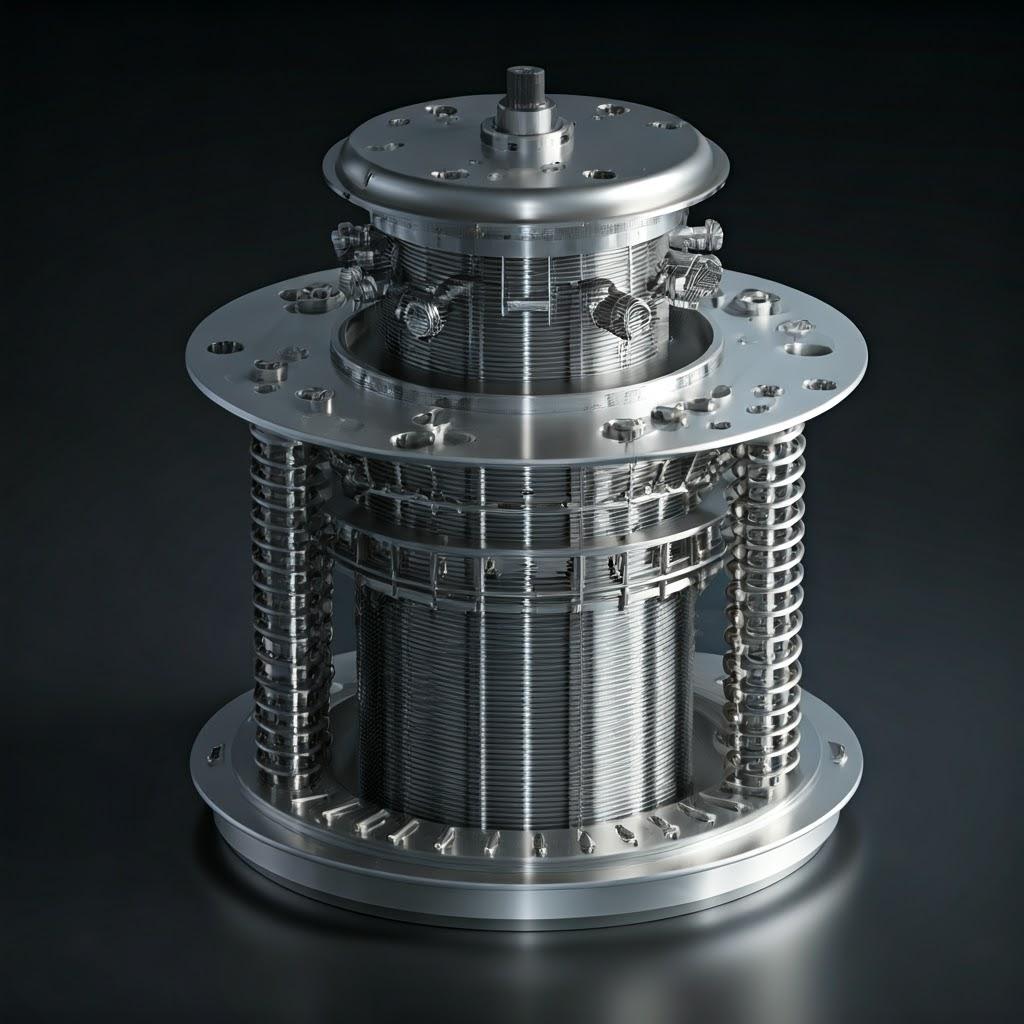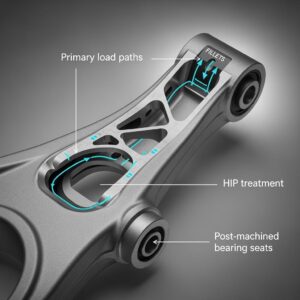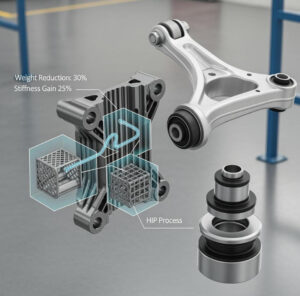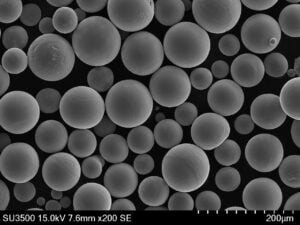Lightweight Satellite Frames: Revolutionizing Aerospace with Metal 3D Printing
Оглавление
Introduction: The Critical Role of Lightweighting in Satellite Technology
In the relentless pursuit of enhanced performance and reduced launch costs within the aerospace industry, the development of lightweight yet robust satellite frames has become paramount. Every kilogram shaved off a satellite’s structure translates directly into significant savings in fuel consumption for orbital maneuvers or allows for the inclusion of more sophisticated and powerful payloads. This demand for lighter components has spurred innovation in materials science and manufacturing technologies, positioning metal 3D printing, also known as metal additive manufacturing, as a transformative solution. At Metal3DP Technology Co., LTD, we understand the critical importance of lightweighting in satellite design and are at the forefront of providing advanced metal 3D-печать solutions tailored to meet these demanding requirements. Our industry-leading print volume, accuracy, and reliability ensure the production of mission-critical satellite components that push the boundaries of what’s possible in space.
What are Lightweight Satellite Frames Used For? Exploring Key Applications
Lightweight satellite frames serve as the structural backbone of spacecraft, providing essential support and mounting points for a multitude of critical subsystems. Their applications span a wide array of satellite types and missions, including:
- Communication Satellites: Supporting antennas, transponders, and other communication equipment for broadcasting, internet services, and data transfer. The reduced weight allows for larger payloads and extended operational lifespans.
- Earth Observation Satellites: Housing sophisticated sensors and cameras for weather monitoring, environmental studies, and surveillance. Lighter frames enable greater instrument capacity and improved maneuverability for precise data acquisition.
- Navigation Satellites: Providing a stable platform for highly accurate atomic clocks and GPS/GNSS transmitters. Weight reduction contributes to improved orbital stability and longevity of the constellation.
- Scientific Research Satellites: Supporting telescopes, spectrometers, and other scientific instruments for space exploration and fundamental research. Lightweighting allows for larger and more sensitive instruments to be deployed.
- Small Satellites (CubeSats, SmallSats): Enabling cost-effective access to space for various applications, from technology demonstration to remote sensing. Metal 3D printing facilitates the creation of complex, lightweight structures optimized for these smaller platforms.
- Interplanetary Probes: Providing structural integrity during launch and throughout long-duration space travel. Minimizing weight is crucial for maximizing payload capacity for scientific experiments.
The ability to customize the geometry and internal structure of satellite frames through metal 3D printing opens up new possibilities for optimizing space utilization and enhancing overall mission performance. Explore our metal 3D printing services to discover how we can support your specific application needs.

Why Use Metal 3D Printing for Lightweight Satellite Frames? The Advantages of Additive Manufacturing
Opting for metal 3D printing over traditional manufacturing methods offers a compelling array of advantages for the production of lightweight satellite frames:
- Weight Optimization through Design Freedom: Additive manufacturing allows for the creation of complex geometries, including intricate lattice structures and internal cavities, which are virtually impossible to achieve with conventional techniques like machining or casting. This design freedom enables engineers to optimize the frame’s structure for maximum strength-to-weight ratio, leading to significant weight reduction without compromising structural integrity.
- Эффективность использования материалов и сокращение отходов: Metal 3D printing utilizes a layer-by-layer deposition process, adding material only where it’s needed. This drastically reduces material waste compared to subtractive methods, where significant amounts of material are removed to create the final part. This efficiency is particularly valuable when working with expensive aerospace-grade alloys.
- Part Consolidation and Reduced Assembly: Complex satellite frame assemblies often require multiple individual components that need to be joined together using fasteners, welding, or other methods. Metal 3D printing enables the consolidation of several parts into a single, monolithic structure, eliminating the weight and potential failure points associated with joints and fasteners.
- Быстрое создание прототипов и итерации: The speed and flexibility of metal 3D printing accelerate the design and development cycle. Engineers can quickly iterate on different frame designs, produce prototypes, and test their performance, leading to faster optimization and reduced time-to-market.
- Customization and Complexity: Each satellite mission may have unique structural requirements. Metal 3D printing offers unparalleled customization, allowing for the creation of frames tailored precisely to the specific needs of the payload and mission profile, without the added cost and lead time associated with custom tooling for traditional manufacturing.
- Enhanced Performance Characteristics: Through careful material selection and optimized designs, metal 3D printed satellite frames can exhibit superior mechanical properties, such as increased stiffness, improved vibration damping, and enhanced thermal management capabilities, contributing to the overall performance and reliability of the satellite.
На сайте Metal3DP, our advanced Selective Electron Beam Melting (SEBM) printers are particularly well-suited for producing complex, high-performance aerospace components like satellite frames, offering exceptional accuracy and material properties.
Recommended Materials and Why They Matter: AlSi10Mg and Scalmalloy®
The selection of the appropriate metal powder is crucial for achieving the desired performance characteristics of a lightweight satellite frame. At Metal3DP, we offer a range of high-quality metal powders optimized for additive manufacturing, including:
- AlSi10Mg: This aluminum alloy is a popular choice for aerospace applications due to its excellent strength-to-weight ratio, good thermal conductivity, and corrosion resistance. | Property | Value | Significance for Satellite Frames | | :—————————– | :————————————- | :———————————————————————————————————————————————————————————————————————————————————————————- | | Density | ~2.67 g/cm³ | Low density contributes to significant weight reduction, crucial for minimizing launch costs and improving satellite efficiency. | | Tensile Strength (as printed) | ~350-420 MPa | Provides sufficient structural integrity to withstand launch stresses and operational loads in space. | | Yield Strength (as printed) | ~240-300 MPa | Indicates the material’s resistance to permanent deformation under stress, ensuring the frame maintains its shape and functionality. | | Thermal Conductivity | ~120-160 W/m·K | Good thermal conductivity helps dissipate heat generated by onboard electronics, contributing to the thermal management of the satellite. | | Corrosion Resistance | Good | Ensures the long-term durability of the frame in the harsh space environment. | | Suitability for 3D Printing | Excellent (Laser Powder Bed Fusion) | Well-established process parameters and good printability ensure high-quality, complex geometries can be achieved with precision. |
- Scalmalloy®: This high-performance aluminum-magnesium-scandium alloy offers an exceptional combination of strength and low density, making it an ideal candidate for highly stressed, lightweight aerospace structures. | Property | Value | Significance for Satellite Frames | | :—————————– | :————————————- | :———————————————————————————————————————————————————————————————————————————————————————————- | | Density | ~2.59 g/cm³ | Even lower density than AlSi10Mg, offering further potential for weight savings. | | Tensile Strength (as printed) | ~480-520 MPa | Superior strength allows for the design of even lighter structures while maintaining or improving load-bearing capabilities. | | Yield Strength (as printed) | ~430-480 MPa | High yield strength provides excellent resistance to permanent deformation under demanding operational conditions. | | Thermal Conductivity | ~130-150 W/m·K | Comparable thermal conductivity to AlSi10Mg, facilitating effective heat dissipation. | | Corrosion Resistance | Good | Ensures long-term reliability in the space environment. | | Suitability for 3D Printing | Excellent (Laser Powder Bed Fusion) | Demonstrates excellent printability, allowing for the creation of intricate and optimized lightweight designs. |
Our advanced powder making system, utilizing industry-leading gas atomization technology, ensures that our AlSi10Mg and Scalmalloy® powders exhibit high sphericity and flowability, crucial for achieving dense, high-quality 3D printed parts with superior mechanical properties. Learn more about our high-quality metal powders here.

Design Considerations for Additive Manufacturing of Satellite Frames
Optimizing the design of a satellite frame for metal 3D printing requires a different approach compared to traditional manufacturing. Embracing the unique capabilities of additive manufacturing can lead to significant improvements in weight, performance, and functionality. Here are key design considerations:
- Topology Optimization: This computational design approach identifies the most efficient material distribution for a given set of loads and constraints. By removing material from low-stress areas, topology optimization can generate highly organic and lightweight structures that would be impossible to manufacture using conventional methods. Metal 3D printing excels at realizing these complex, optimized geometries.
- Решетчатые структуры: Incorporating lattice or cellular structures within the satellite frame’s design can significantly reduce weight while maintaining or even enhancing stiffness and strength. These intricate internal networks offer a high surface area-to-volume ratio and can be tailored to specific load-bearing requirements. Various lattice types, such as gyroids, honeycombs, and cubic lattices, can be implemented depending on the application.
- Generative Design: Utilizing artificial intelligence (AI) and algorithms to explore a vast design space based on predefined parameters (e.g., weight, stiffness, stress) can lead to innovative and non-intuitive structural solutions. Generative design tools can create optimized geometries that meet performance requirements while minimizing material usage, perfectly aligning with the goal of lightweighting.
- Orientation and Support Structures: The orientation of the part during the 3D printing process significantly impacts surface finish, support material requirements, and build time. Careful consideration of the build orientation and the strategic placement of support structures are crucial for minimizing post-processing efforts and ensuring dimensional accuracy. Design features like self-supporting angles and breakaway supports can further streamline the process.
- Wall Thickness and Ribbing: Optimizing wall thicknesses and incorporating strategically placed ribs or stiffeners can enhance the structural integrity of the frame without adding excessive weight. Variable wall thicknesses can be employed to match local stress concentrations, while ribs can provide reinforcement in critical areas.
- Integration of Features: Additive manufacturing allows for the direct integration of features such as mounting brackets, cable routing channels, and thermal management pathways into the satellite frame design. This reduces the need for separate components and fasteners, further contributing to weight reduction and simplified assembly.
By considering these design principles and leveraging the capabilities of metal 3D printing, engineers can create innovative and highly efficient lightweight satellite frames. Met3DP’s expertise in additive manufacturing and materials science can help you optimize your designs for peak performance.
Tolerance, Surface Finish, and Dimensional Accuracy in Metal 3D Printed Satellite Frames
Achieving the required levels of tolerance, surface finish, and dimensional accuracy is paramount for the functional integration and overall performance of satellite frames. Metal 3D printing technologies have made significant strides in this regard, and with careful process control and post-processing, stringent aerospace requirements can be met.
- Tolerance Capabilities: The achievable tolerances in metal 3D printing depend on the specific technology used (e.g., Laser Powder Bed Fusion, Electron Beam Melting), the material, and the part geometry. Typically, tolerances in the range of ±0.1 mm or even finer can be achieved for critical dimensions. For features requiring tighter tolerances, post-processing steps like CNC machining can be employed.
- Отделка поверхности: The as-built surface finish of metal 3D printed parts is generally rougher than that achieved by traditional machining. The surface roughness is influenced by factors such as powder particle size, layer thickness, and build orientation. For applications requiring smoother surfaces, various post-processing techniques like media blasting, polishing, and chemical etching can be utilized to achieve the desired finish.
- Точность размеров: Dimensional accuracy refers to the degree to which the printed part matches the intended design dimensions. Factors affecting accuracy include machine calibration, thermal expansion and contraction during the build process, and material shrinkage upon solidification. Advanced process control strategies, optimized build parameters, and accurate design compensation can minimize dimensional deviations.
- Неразрушающий контроль (NDT): To ensure the structural integrity and dimensional accuracy of critical satellite frame components, NDT methods such as computed tomography (CT scanning), ultrasonic testing, and dye penetrant inspection can be employed to detect internal defects and verify dimensional conformance.
- Metrology and Quality Control: Precise measurement and quality control procedures are essential throughout the additive manufacturing process. Coordinate Measuring Machines (CMMs) and other advanced metrology equipment are used to verify the dimensional accuracy of the printed parts against the design specifications.
At Metal3DP, we are committed to achieving the highest standards of quality and precision in our metal 3D printing services for the aerospace industry. Our advanced equipment and experienced team ensure that your satellite frames meet the most demanding tolerance and accuracy requirements.

Post-Processing Requirements for Metal 3D Printed Satellite Frames
While metal 3D printing offers significant advantages in terms of design freedom and material efficiency, post-processing steps are often necessary to achieve the final desired properties and surface finish of satellite frames. Common post-processing requirements include:
- Удаление опоры: Support structures are often required during the 3D printing process to prevent part deformation and ensure build stability, especially for complex geometries with overhangs. These supports need to be carefully removed after the printing is complete. The method of support removal can vary depending on the material and the support structure design (e.g., manual removal, machining, chemical dissolution).
- Термообработка: Heat treatment is a crucial step for optimizing the mechanical properties of metal 3D printed parts. Processes like stress relieving, annealing, hot isostatic pressing (HIP), and solution annealing followed by aging can be employed to improve strength, ductility, and fatigue resistance, ensuring the frame can withstand the harsh conditions of space.
- Отделка поверхности: As mentioned earlier, post-processing techniques like media blasting, polishing (mechanical or electrochemical), and chemical etching can be used to achieve the desired surface finish, which may be required for thermal control, outgassing considerations in vacuum, or cosmetic reasons.
- CNC Machining: For features requiring very tight tolerances or specific surface finishes that are difficult to achieve directly through 3D printing, precision CNC machining can be employed as a secondary operation. This hybrid manufacturing approach combines the design flexibility of additive manufacturing with the accuracy of subtractive methods.
- Coating and Surface Treatments: Depending on the mission requirements, satellite frames may require specific coatings or surface treatments to enhance corrosion resistance, thermal emissivity, or electrical conductivity. Examples include anodizing, painting, or vacuum deposition of thin films.
- Inspection and Quality Assurance: Final inspection, including dimensional checks and non-destructive testing, is a critical post-processing step to ensure that the manufactured satellite frame meets all the required specifications and quality standards for aerospace applications.
Metal3DP offers comprehensive post-processing services to ensure that your metal 3D printed satellite frames meet the most stringent aerospace requirements, providing a complete manufacturing solution from design to finished part.
Common Challenges and How to Avoid Them in Metal 3D Printing of Satellite Frames
While metal 3D printing offers numerous benefits, there are also potential challenges that need to be addressed to ensure the successful fabrication of high-quality satellite frames:
- Warping and Distortion: Thermal stresses during the printing process can lead to warping or distortion of the part, particularly for large or complex geometries. Careful optimization of build parameters, part orientation, and support structures can minimize these effects. Simulation tools can also help predict and mitigate potential distortion.
- Porosity and Density Issues: Achieving high density and minimizing porosity are crucial for the mechanical performance of aerospace components. Inadequate process parameters or powder quality can lead to internal voids and weaknesses. Utilizing high-quality metal powders from reputable suppliers like Metal3DP and optimizing printing parameters are essential for achieving dense, defect-free parts.
- Support Structure Removal Difficulties: Aggressively attached support structures can be challenging to remove without damaging the part’s surface. Designing smart support structures with breakaway features and optimizing their placement can simplify removal.
- Surface Roughness Exceeding Requirements: The as-built surface finish may not meet the requirements for certain applications. Implementing appropriate post-processing techniques and optimizing build parameters can address this issue.
- Dimensional Inaccuracies: Deviations from the intended design dimensions can occur due to factors like thermal contraction and machine calibration. Accurate machine calibration, design compensation, and process optimization are crucial for achieving the required dimensional accuracy.
- Material Property Variability: Variations in material properties can occur if the printing process is not well-controlled. Maintaining consistent process parameters, using certified materials, and implementing robust quality control measures are essential for ensuring the repeatability and reliability of the printed parts.
- Cost Considerations for Complex Geometries: While metal 3D printing can be cost-effective for complex, low-volume production, the cost per part can increase for very intricate designs or large build volumes due to longer print times and increased material consumption for support structures. Design optimization to minimize complexity and support requirements can help mitigate these costs.
By understanding these potential challenges and implementing appropriate design strategies, process controls, and post-processing techniques, it is possible to successfully leverage metal 3D printing for the production of high-quality, lightweight satellite frames. Metal3DP’s expertise and comprehensive solutions can help you navigate these challenges and achieve your manufacturing goals.

How to Choose the Right Metal 3D Printing Service Provider for Satellite Frames
Selecting the right metal 3D printing service provider is a critical decision that can significantly impact the success of your satellite frame project. Here are key factors to consider when evaluating potential suppliers:
- Material Capabilities: Ensure the provider has experience processing the specific metal alloys required for your application (e.g., AlSi10Mg, Scalmalloy®). Verify their expertise in optimizing printing parameters for these materials to achieve the desired mechanical properties and density. Metal3DP offers a wide range of high-performance metal powders specifically tailored for demanding applications.
- Technology and Equipment: Understand the types of metal 3D printing technologies the provider utilizes (e.g., Laser Powder Bed Fusion (LPBF), Electron Beam Melting (EBM)). For aerospace applications, technologies like EBM, which is employed by Metal3DP, can offer advantages in terms of build volume, accuracy, and material properties for certain alloys.
- Quality Management and Certifications: Inquire about the provider’s quality management systems and certifications (e.g., ISO 9001, AS9100 for aerospace). These certifications demonstrate their commitment to quality control, process consistency, and traceability, which are crucial for aerospace components.
- Design and Engineering Support: A strong service provider should offer design and engineering support to help optimize your satellite frame for additive manufacturing. This includes expertise in topology optimization, lattice design, and build orientation to maximize performance and minimize weight. Metal3DP provides comprehensive application development services to assist you throughout the design and manufacturing process.
- Post-Processing Capabilities: Ensure the provider offers the necessary post-processing services to meet your requirements, including support removal, heat treatment, surface finishing, and inspection. A comprehensive in-house capability can streamline the production process and ensure quality.
- Experience in Aerospace or Similar Industries: Prior experience in working with aerospace companies or other highly regulated industries is a significant advantage. It indicates an understanding of the stringent quality standards, material requirements, and documentation needs of the sector.
- Lead Times and Production Capacity: Discuss lead times for prototyping and production, as well as the provider’s capacity to handle your anticipated volumes. Ensure their capabilities align with your project timelines.
- Cost Structure and Transparency: Obtain a clear understanding of the pricing structure, including material costs, printing fees, and post-processing charges. A transparent and competitive pricing model is essential.
- Communication and Customer Support: Effective communication and responsive customer support are crucial for a successful partnership. Choose a provider that is proactive, communicative, and willing to collaborate.
By carefully evaluating these factors, you can select a metal 3D printing service provider that can reliably produce high-quality, lightweight satellite frames that meet your specific requirements.
Cost Factors and Lead Time for Metal 3D Printed Satellite Frames
Understanding the factors that influence the cost and lead time for metal 3D printed satellite frames is essential for effective project planning and budgeting:
Факторы стоимости:
- Материальные затраты: The cost of the metal powder is a significant factor. Aerospace-grade alloys like AlSi10Mg and Scalmalloy® can be more expensive than standard metals. The quantity of material used, which is influenced by the part’s volume and the amount of support structures required, also impacts the overall material cost.
- Время печати: The duration of the 3D printing process is a key cost driver. Longer build times, often associated with larger parts or finer layer resolutions, increase machine usage costs.
- Machine Usage and Overhead: Service providers factor in the cost of operating and maintaining their 3D printing equipment, as well as general overhead expenses.
- Расходы на постобработку: The extent of post-processing required (e.g., support removal, heat treatment, machining, surface finishing) significantly affects the final cost. Complex post-processing workflows will increase expenses.
- Design Complexity and Optimization: While 3D printing excels at complex geometries, highly intricate designs may require more design effort and longer print times, potentially increasing costs. Design optimization for manufacturability can help mitigate this.
- Quantity and Production Volume: While 3D printing is often cost-effective for low to medium volumes and complex parts, the cost per part may decrease with larger production runs due to economies of scale in material procurement and process optimization.
- Quality Assurance and Inspection: Stringent quality control procedures and non-destructive testing, often required for aerospace applications, can add to the overall cost.
Lead Time Factors:
- Design and Engineering Phase: The time required for design optimization, simulation, and build preparation can influence the overall lead time.
- Время печати: As mentioned earlier, the duration of the 3D printing process itself is a significant component of the lead time.
- Post-Processing Time: The time required for various post-processing steps can vary depending on the complexity and the number of operations involved.
- Quality Control and Inspection: Thorough inspection processes can add to the lead time but are crucial for ensuring part quality.
- Scheduling and Production Queue: The service provider’s current workload and production schedule can impact the turnaround time.
- Shipping and Logistics: The time required for shipping the finished parts to the customer also needs to be considered.
By understanding these cost and lead time factors, you can have more informed discussions with potential service providers like Metal3DP and plan your project effectively.

Часто задаваемые вопросы (FAQ)
- Can metal 3D printed satellite frames meet aerospace industry standards? Yes, with the right materials, processes, and quality control measures, metal 3D printed parts can meet stringent aerospace industry standards. Providers with AS9100 certification and expertise in processing aerospace-grade alloys are well-equipped to produce compliant components. Metal3DP adheres to rigorous quality standards to ensure the reliability and performance of our 3D printed metal parts.
- What are the typical weight savings achievable with metal 3D printed satellite frames compared to traditionally manufactured ones? Weight savings can vary significantly depending on the design and application, but reductions of 20-50% or more are often achievable by leveraging topology optimization, lattice structures, and part consolidation made possible by metal 3D printing.
- Is metal 3D printing cost-effective for producing satellite frames? Metal 3D printing can be highly cost-effective, especially for complex, low-to-medium volume production runs where traditional tooling costs would be high. The ability to optimize designs for weight reduction and part consolidation can also lead to long-term cost savings in terms of launch costs and assembly.
Conclusion: Embracing the Future of Lightweight Satellite Structures with Metal 3D Printing
Metal 3D printing stands as a transformative technology for the design and manufacturing of lightweight satellite frames. Its ability to enable complex geometries, optimize material usage, and consolidate parts offers significant advantages in terms of weight reduction, performance enhancement, and faster development cycles for the aerospace industry. Companies like Metal3DP Technology Co., LTD are at the forefront of this revolution, providing advanced metal AM solutions, high-quality materials like AlSi10Mg and Scalmalloy®, and comprehensive services to empower the next generation of space exploration and satellite technology. By embracing the design freedom and manufacturing capabilities of metal 3D printing, the aerospace industry can continue to push the boundaries of what’s possible in orbit and beyond.
Поделиться
MET3DP Technology Co., LTD - ведущий поставщик решений для аддитивного производства со штаб-квартирой в Циндао, Китай. Наша компания специализируется на производстве оборудования для 3D-печати и высокопроизводительных металлических порошков для промышленного применения.
Сделайте запрос, чтобы получить лучшую цену и индивидуальное решение для вашего бизнеса!
Похожие статьи

Metal 3D Printing for U.S. Automotive Lightweight Structural Brackets and Suspension Components
Читать далее "О компании Met3DP
Последние обновления
Наш продукт
CONTACT US
Есть вопросы? Отправьте нам сообщение прямо сейчас! После получения Вашего сообщения мы всей командой выполним Ваш запрос.
Получите информацию о Metal3DP
Брошюра о продукции
Получить последние продукты и прайс-лист









